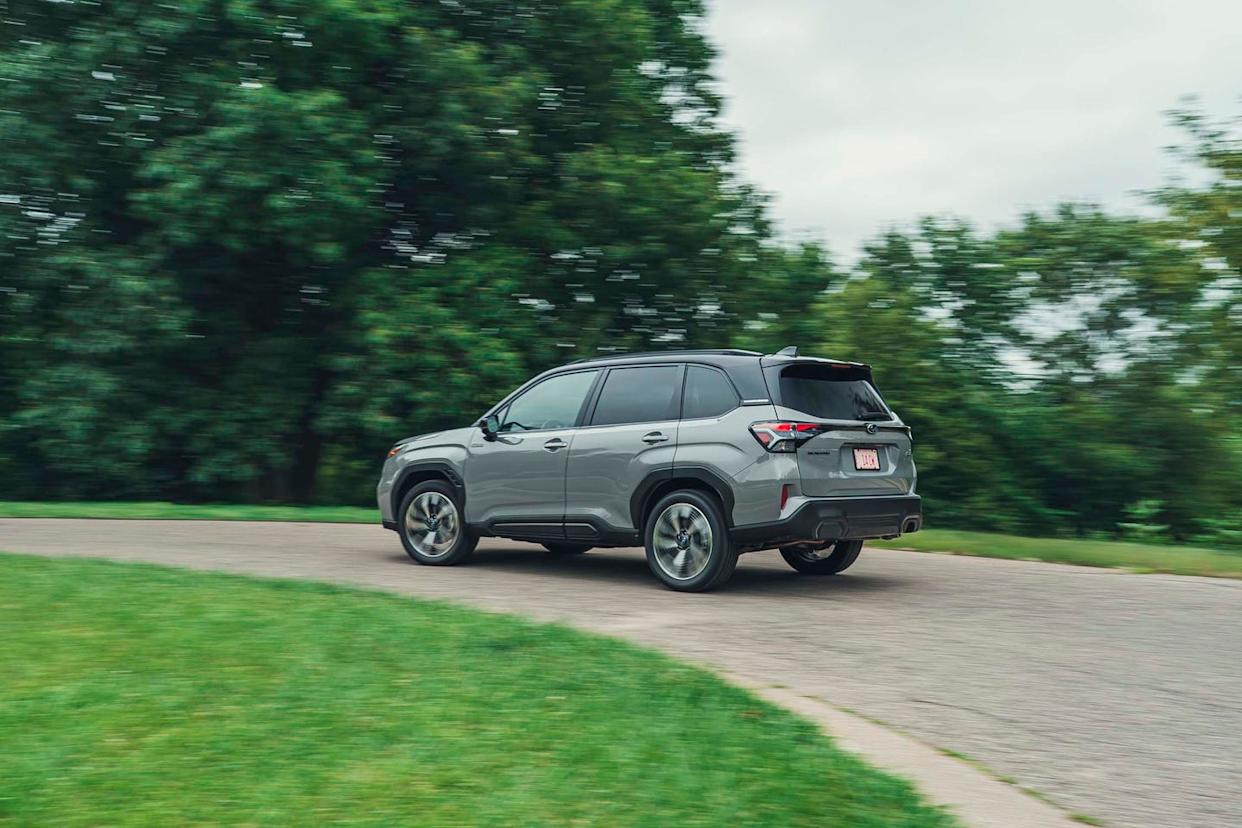
7/31/25 UPDATE: This review has been updated with instrumented test results.
We've bemoaned the refreshed 2025 Subaru Forester for its lack of vitality, but that was before we had a chance to drive something that's never before existed: the Subaru Forester Hybrid. This changes more than you'd think. Yes, there's a bump in fuel economy: from 28 mpg combined (with 19-inch wheels) or 29 mpg (with 17- or 18-inchers) for the regular Forester to 35 mpg combined for the hybrid. And for some people that'd be enough.
Subaru's New Hybrid System
Power still doesn't crack the 200-hp threshold, but it's now closer at 194 horsepower. Compare that to the 180-hp effort of the regular Forester, and you've got yourself a 14-hp advantage. Okay, golf clap. Still, the way this hybrid compact crossover goes about its business is what makes the difference. It starts with a 2.5-liter boxer engine as in the standard car, but this one is tuned to run the Atkinson cycle. It makes 162 horsepower and 154 pound-feet of torque, which doesn't sound that great until you realize that the hybrid system blends in another 118 horsepower and 199 pound-feet from the primary traction motor concealed within the transmission case.
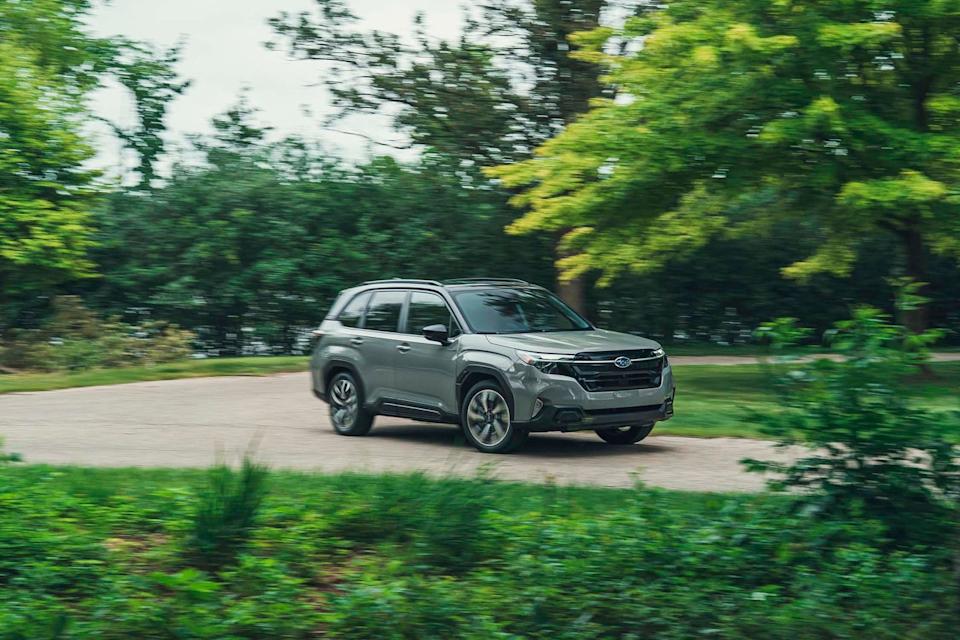
Another motor-generator within the transmission case does the hero's work of starting the engine, siphoning off excess power to generate electricity for the battery, and regulating the output of the engine and traction motor as the arbiter of the CVT action of the transmission. It doesn't contribute to propulsion, so its output isn't listed, but it is the main player behind the scenes of the whole contraption. What's more, the CVT action here is less prone to vibration than Subaru's Lineartronics of old, because there's no friction in how this one operates. Consisting of a planetary gearset instead of a pair of adjustable pulleys and a chain belt, it's far smoother.
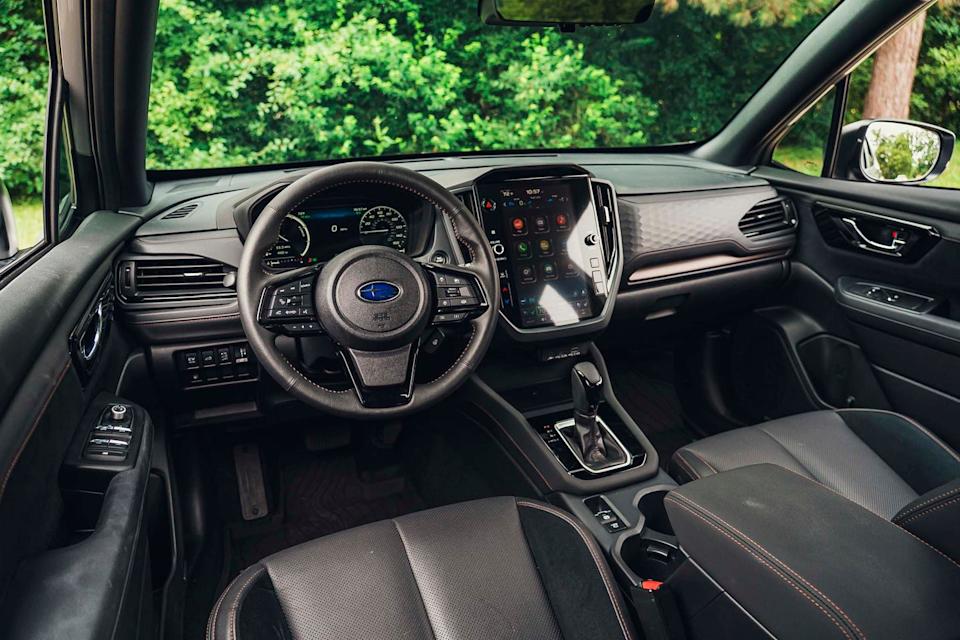
The Hybrid in Action
On the drag strip, though, the hybrid isn't liable to be much quicker than the nonhybrid. That's because most of its horsepower advantage is negated by the powertrain's extra weight. (Our 3937-pound test car weighed 281 pounds more than the last nonhybrid version we tested, which makes it almost a draw when you do the power-to-weight calculation.) But the electric motor gives the Forester Hybrid far more motivation moving off from a stop. You won't see it at 60 mph, where its 8.6-second effort actually trails the nonhybrid by 0.3 second, but it is quicker to 20, 30, and 40 mph by 0.4, 0.6, and 0.5 second. Passing acceleration from 30 to 50 mph is two-tenths better as well, and the run from 50 to 70 mph is a significant 0.7 second quicker.
The overriding theme is quiet. Our 70-mph cruise test bears that out with a 68-decibel performance, down from 70 decibels in the nonhybrid version. That's because the Forester Hybrid has been given even more sound deadening. Of course, it also operates sometimes as an EV, and we saw the EV mode light up on downhills at 60 mph and even for brief stretches while cruising too. The background noise doesn't really change much when you're driving, and the engine-on phases aren't much different from the engine-off ones. The exception, of course, is acceleration, but even this is muted unless you've got your foot in it. If you do mash it, the hybrid still pips the nonhybrid by a decibel, 73 to 74.
One thing that many overlook with an all-wheel-drive hybrid is the way power is routed to all four wheels. With the Forester Hybrid, the engine and hybrid system all sit upstream of the all-wheel-drive transfer case, meaning all four wheels are driven by the hybrid powertrain. In other all-wheel-drive hybrids, particularly the Toyota RAV4 Hybrid, the hybrid powertrain only drives the front wheels; the rear axle is powered by a third electric motor when necessary. It's not a great way to run a railroad, some might say. Electric motors deploy their power differently, so the front and rear ends might not speak the same language. Also, they may not be up for continuous all-wheel action. Subaru does pay a fuel-economy penalty for doing it this way, however. The Forester Hybrid's 35 mpg combined is 4 mpg lower than the RAV4 Hybrid's 39 mpg. We averaged 31 mpg overall.
The switch to hybrid propulsion necessitated certain other changes as well. The AC compressor is electrically powered and is canted off-axis from the accessory drive belt. Other changes were made to the brakes, because they need to maintain a steady pedal feel whether you are regenerating electricity to do the slowing or using the pads and rotors. Subaru nailed this, because the brake pedal feel is smooth and sure throughout; there's no hiccup when the brakes transition from one to the other. The only small gripe is that they're a wee bit oversensitive initially, and their ultimate stopping power is good for 181 feet in a 70-mph panic stop, some nine feet farther than the nonhybrid on similar 19-inch all-season tires.
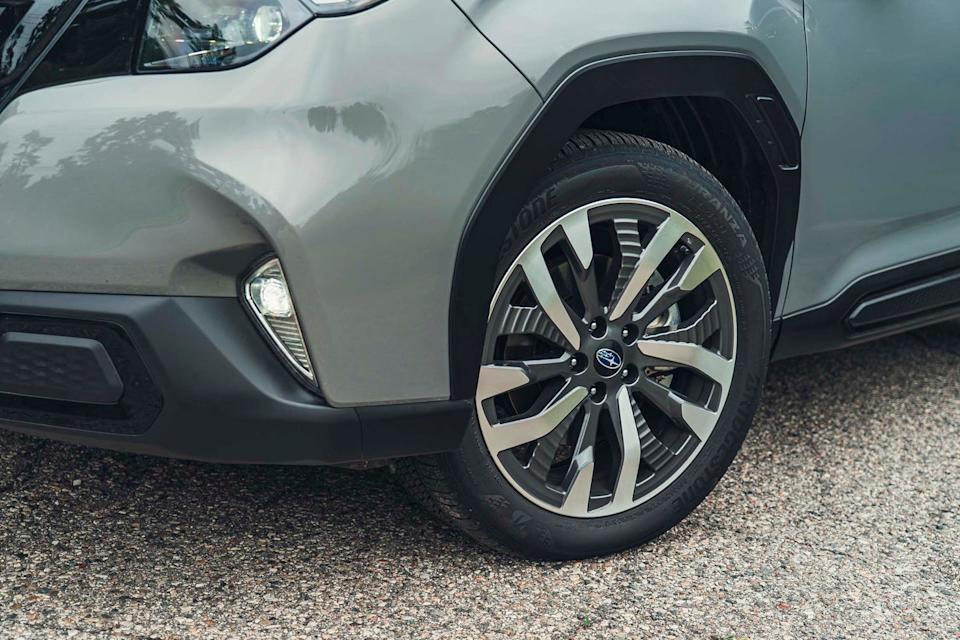
The suspension has been reworked owing to the extra weight. Still, the extra poundage probably accounts for the slight slip in stopping distance and an equally minute drop in skidpad grip, from 0.82 to 0.80 g. We spent the bulk of our time driving a Forester Hybrid in Michigan and on the narrow twisty lanes above Woodside, California, and it felt absolutely planted, but with a comportment that still breathed. The body didn't roll excessively, and you never had any sense that there's 8.7 inches of ground clearance underneath you. The steering is lighter than is our taste, but at the same time it never once gave us a bum steer. The road turned back on itself more times than we can recall, and yet we always hit our marks with ease.
As has been said before, the visibility out of the Forester is pretty damn impressive. Ditto the accommodations, which are ample whether you're in the front seats or the back. The front chairs are nicely bolstered, and we appreciated them when sailing along twisty Skyline Drive. We'll even give a shout-out to the driver-assist nannies. We'll often turn off lane-departure warning, but Subaru's EyeSight seems to be sophisticated enough to distinguish between intentional line-tickling and outright inattention. Whatever the case, a system that doesn't react needlessly is the one that won't get switched off, meaning it will be on duty when you do need it.
The Hybrid Upcharge
We previously posited that the hybrid would be "about $5000 more" than the regular version, but that's not quite true. Yes, the nonhybrid base model is actually $6600 less than the hybrid's starting price, but that's because the least expensive hybrid is the one-level-up Premium trim level. Starting at $38,015 and climbing to $44,715 for the Touring, the hybrid's upcharge ranges from $1700 to $3490 bucks. For that, you also get more standard equipment and a hybrid-exclusive digital cockpit display, so the real price delta for the hybrid is more like $1700 to $2010. That's the dollar amount you really need to look at if you want to consider the payback for the 35-mpg combined rating that you get with the hybrid. We did, and it's fewer than five years at national average pump prices.
Of course, there's a bit more to the hybrid Forester than that. You also get a quieter car, slightly more oomph at takeoff, and the digital gauge cluster that can put maps right in front of your face. Moreover, you get a well-tuned Forester that's nicer to drive than you'd guess.
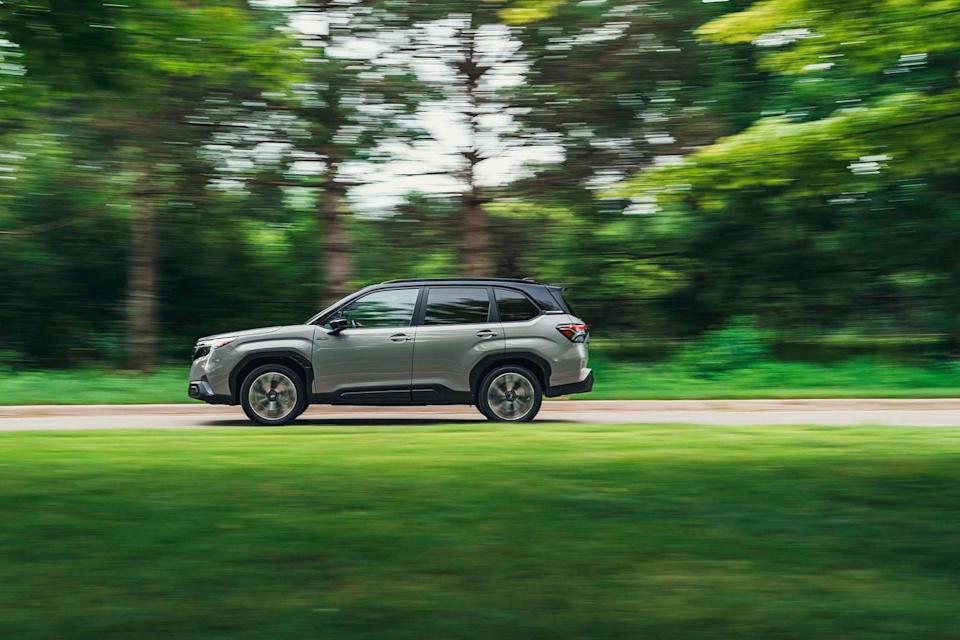
You Might Also Like
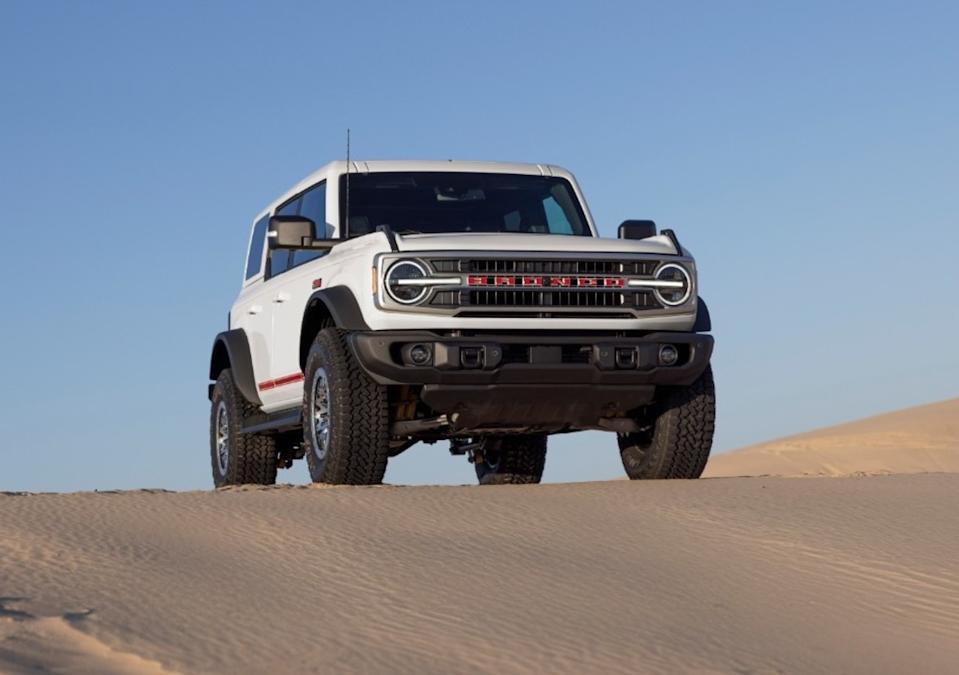



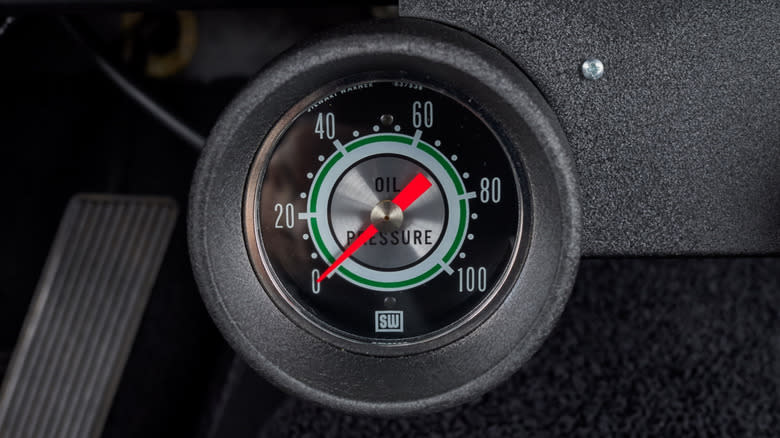


Comments